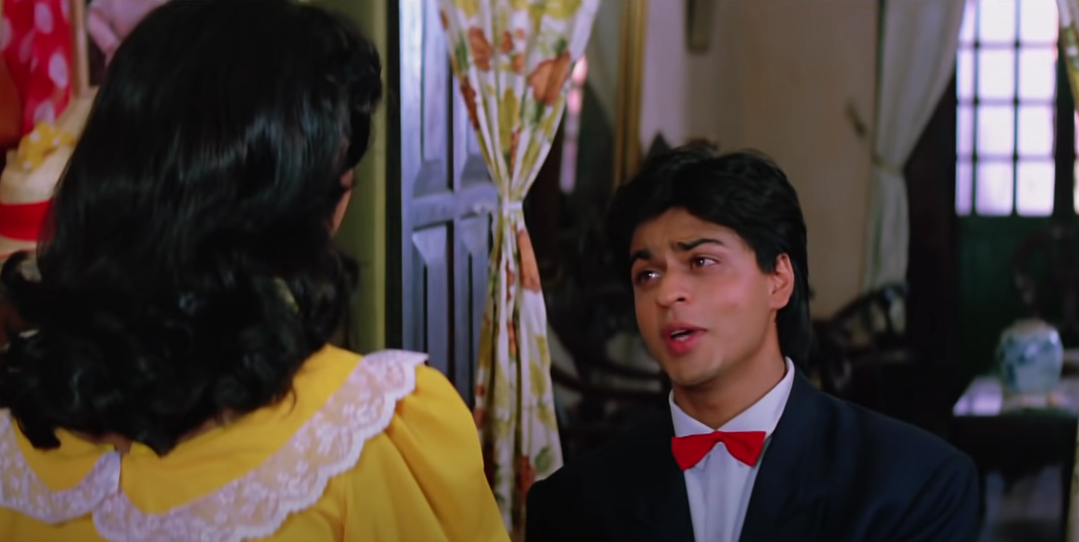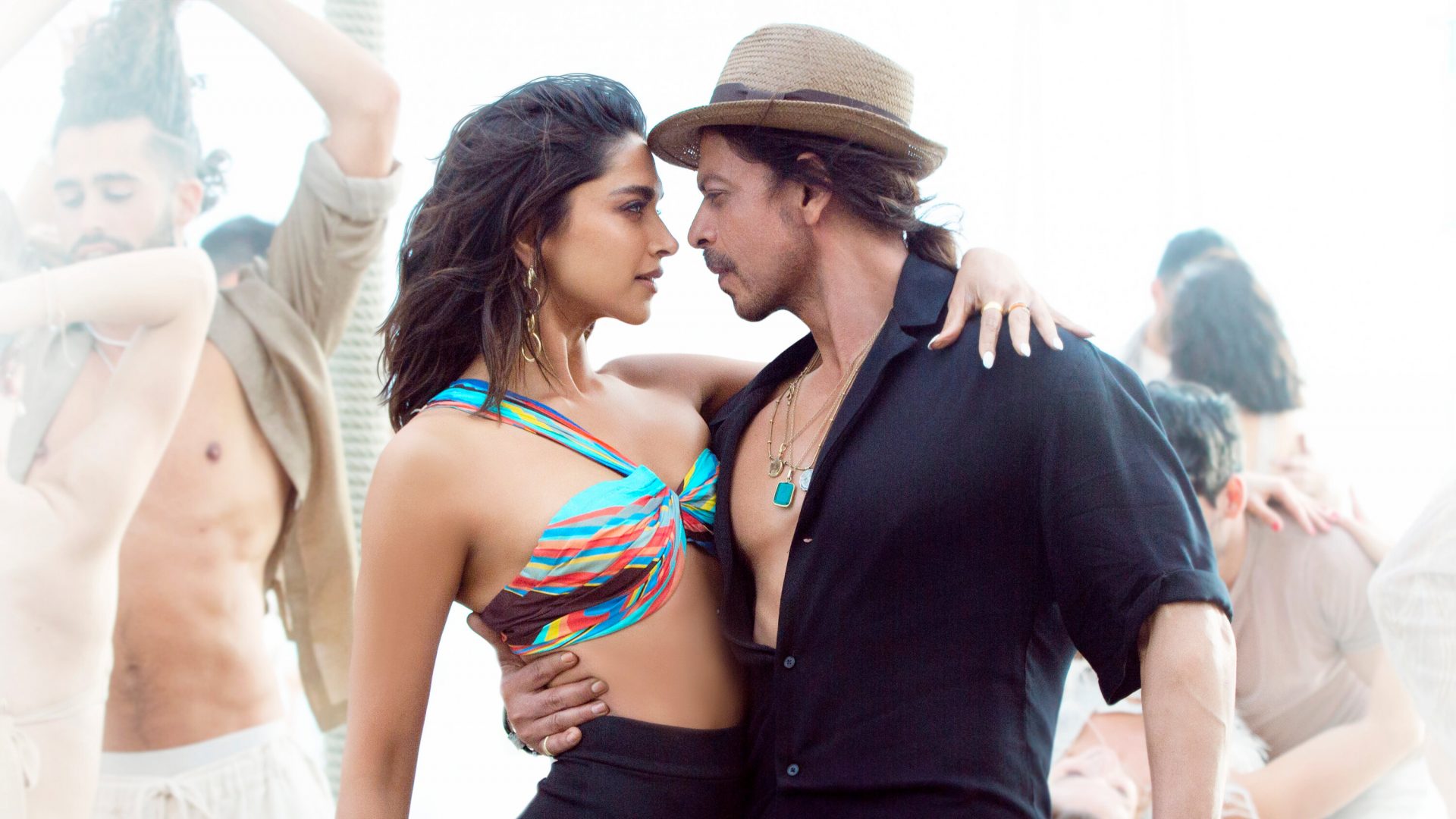I risk losing a few readers in the very first paragraph, yet it won’t stop me from dishing out a few obvious here. The Badshah of Bollywood’s comeback vehicle is a very mediocre film- but a gigantic achievement in terms of making a mass movie that serves the fable of the superstar. Another thing that we should agree on is Shah Rukh Khan is still the epitome of Romance in an out-and-out action flick, and he is the embodiment of everything that is India. For the skeptics, I am here to reason.
Shah Rukh Khan as the Myth and Mass-hero
By definition, a mass film only exists to celebrate its superstar- this formula was perfected by many Rajinikanth movies and has a legacy that successfully lives on with Vijay and Salman movies in recent years. Shah Rukh has never attempted a mass film, probably because he never felt the need to project himself with such grandeur of a hero. He is an everyman who has occupied the imagination of this country for years- often charming his way through Romantic masala movies with way less testosterone than all the superstars who share the pedestal with him.
I remember reading a review by Baradwaj Rangan commenting on SRK’s Don: “this funny exotica is meant to make you contrast the world of this Don with that of the paan-chewing simpleton.” But Pathaan (2023) is exactly that and, in a thousand ways, more extravagant and exuberant than Don. It leaves no place for a simpleton story to inculcate like it was in the 90s SRK movies, but this fan vehicle was the desperate need of the hour for Bollywood.
Gone are the days when Shah Rukh could charm us despite playing characters who are essentially losers, i.e., Kabhi Haan Kabhi Naa, and Yes Boss. The failure of a movie like Zero perhaps made it clear to him that audiences want to experience his persona in larger-than-life roles. This can be seen as a limitation of SRK’s stardom since his aura isn’t enough anymore to pull the audience, and he needs to compromise with the treatment of the movie. Again, it’s the same for every star in this theatre-goer epidemic.

In recent years, box office returns have established the golden rule; fans are more intrigued by watching their favorite hero on screen as a larger-than-life figure than to watch him disappearing into an everyman skin. There’s no denying that over the years, Shah Rukh amassed enough fascination and mystique around him to create a myth that would put any skeptic to shame for their blasphemy. He himself acknowledges this in a 2019 interview with David Letterman, saying he is merely “an employee of the myth of Shah Rukh Khan.”
Shah Rukh Khan’s films examine how the religio-mythical discourse of Ram is transposed to a secular terrain and allows for a re-imagination of the Ram narrative. This allows both the cinematic and the star text to negotiate with an otherwise religious conception to produce an alternative understanding of the epic hero Ram in a more inclusive idiom and how Ram is translated to an altered metaphor in a secular nation on the trajectory of a globalizing regime.
Myths are endemic to every culture and civilization, almost universally speaking. Shah Rukh’s myths, at their simplest best, provide fable-like narratives with didactic morals and are repeated from word to mouth. Hindi films have been a veritable site of a hegemonic bourgeois ideological discourse and domination. They have also tried to produce the hegemonic myth of a unified, secular nation-almost, an imperative, both ideological and commercial, for popular mass entertainment catering to a large and diverse populace.
Previously, four films from the star Shah Rukh Khan’s filmography suture him to see how certain moments and narrative strategies allow for a secular and creative transcendence of a more denotative meaning of Ram embedded essentially within a Hindu religious discourse. This discourse of Ram gets popularly appropriated and metaphorically deployed in four distinct but not exclusive ways in the four films. Hey Ram, Main Hoon Naa, Swades, and RA.One. The advent of neo-liberal capitalism in a post-liberalization era almost coincided with resurgent Hindu nationalism. It led to a dyadic cultural formation that had its resurgence in terrorist narratives in cinematic texts. Main Hoo Na splits open the Ram narrative, the grand symbolic order by the rapturous eruption of the Real.
The altered discourse on Ram in this film urges upon an introspective secular nation to look for its own true image, now mired in contradiction and fraught with tensions germane to the exclusionary cultural assumptions of majoritarian Hindu nationalism. While Ram represents the secular face of the nation, Raghavan is its dark, atavistic, parochial alterity seeking to destabilize the symbolic order. The other resides within the margins of the nation’s embodied self, Ram as Raghavan, and comes to haunt the myth of a cohesive national unity. Counterposed to the trend of cultural nationalism, Main Hoon Na visits the Ram metaphor enunciates an altered idiom towards imagining the nation’s other- the paranoia regarding the Muslims.
Re-adapting and re-working the mythical Ram discourse in what is analogous to a bricoleur, the political myth of a secular and unified nation, is re-produced in cinematic texts as would be seen in the four films chosen for discussion. Clearly, Shah Rukh, a Muslim superstar, was always positioned and accepted by the country’s populace as a secular figure. Still, his allegiance to the nation has repeatedly been questioned due to the recent right-wing movements and campaigns.
Clearly, the situation demanded him to go beyond the extremism and dichotomy that prevailed in society and act as a unifying symbol. And, like always, fans have poured in and showered their love on their beloved superstar. Many Twitter and Facebook threads show people dancing in the theatres and creating a mass euphoria that was unheard of in Bollywood films, at least in recent years.
Pathaan as a subtle commentary

Shah Rukh moving away from his soft-boy image and adapting roles that showcase machismo isn’t exactly new. The shift started happening from the 2007 movie Om Shanti Om, where he decided to flaunt six-pack abs and make it to the headlines. It became clear with his subsequent film choices that he was catering to his male audience rather than staying loyal to his female fan following or, as it was believed. Economist Shrayana Bhattacharya’s book digs into the admiration and aspiration Indian women have for Shah Rukh, thus calling him the “receptacle of so many of women’s expectations.”
In another instance from the book, a woman says that if a man loves Shah Rukh, he is usually progressive. Though it is clear that SRK elicits female fandom, but he isn’t necessarily a feminist icon, as his unthreatening gait, inviting charm, and witty responses often hide the problematic characters he essayed. Though it’s evident among all the mainstream heroes in the industry, SRK is the most self-aware and knows how to use his stardom to exert a positive message.
In Pathaan, SRK calmly stands with him tied down, watching a valiant Deepika Padukone fight the baddies. He has appreciation in his eyes when her character Rubina takes down everyone with a swagger largely associated with male heroes, subsequently giving the “Women” meme a whole new meaning. Pathaan repeatedly gets outsmarted by her and then saved by her. During most of the movie, Pathaan takes his orders from Nandini, another woman. Even as a high-octane action thriller, this Shah Rukh movie, like most others, eschews male chauvinism and leaves enough agency for women.
Also, Read – 10 Best Shah Rukh Khan Performances
SRK is not near invulnerable or a hypermasculine hitting machine, as he winces in pain as soon as Tiger lays his hands on him. He survives through sheer perseverance, much like Shah Rukh himself, with his silent rebellion against the sporadic hatred and jingoism in this country. Pathaan prefers to listen to his heart rather than blindly follow orders, much like how we have seen Shah Rukh in other movies and interviews till now.
When Rubina asks Pathaan about his identity, he replies that he doesn’t know, being abandoned in childhood at a movie theatre and reared by the people of India. The backstory of Pathan echoes the same of Shah Rukh. Helming from Pathankot, a place no longer in India, he is adopted by the countless cinema-crazy fans of this country, just like his character finds a family amongst an Afghan village. The film thus clarifies Shah Rukh’s position in the identity debate, preferring to see himself as an Indian actor and nothing else.
Why celebrating SRK feels personal
I have seen countless tweets over the past week where people from all backgrounds and locations have described the success of Pathaan as a personal achievement. Shah Rukh himself chose to stay away from the movie’s media promotions, instead trusting his brand SRK to drag the audience to the theatres. This move created a lot of intrigue amongst the audience. In an era with over-saturation of information, fans have been longing to see him on the big screen after four long years, and this marketing strategy played into it.
Also, Read: Fan (2016) Only SRK could have done it!
Additionally, Shah Rukh kept doing Twitter AMAs to promote Pathaan through #askSRK, and he was undeniably at his witty best. Shah Rukh knows he has three releases this year and probably didn’t want too many appearances on the media to keep the mystique around his comeback alive and avoid any unnecessary media controversy. Countless tweets popped up where millennials and Gen-Z wrote about how they took their mothers, aunts, and grandmothers to the theatre who would not watch even a minute of violence on-screen otherwise. But again, this is Shah Rukh on screen, and the giddy joy of watching him on screen is unmatched.
Pathaan as a movie benefits from the audience’s determined resolution to celebrate Shah Rukh Khan on the screen, and surely the filmmakers pre-empted that. The set-pieces, cinematography, dialogues, everything plays to that. It also works tirelessly towards making the brand Shah Rukh synonymous with India. In the era of constant scrutinizing, the Boycott gang has been silent since the release of the movie as everything has been papered over by Shah Rukh and the dialogues- there’s no room for the jingoists to call for the head of the filmmakers.
People going to the theatres and celebrating the movie, thus, is a statement- if not a political one. Honestly, we did shrug off all the clouds and submitted ourselves to our Pathaan. This is the closest Shah Rukh has ever come to winning the heart of India.






